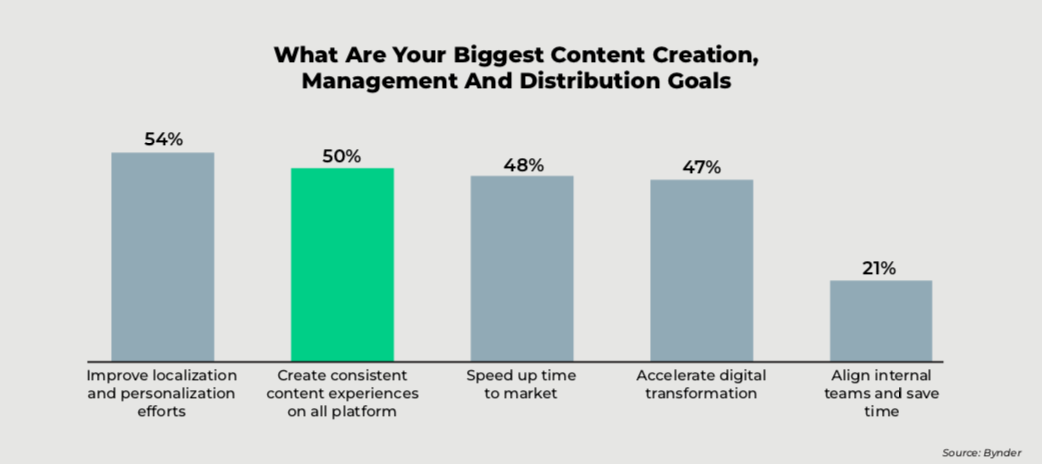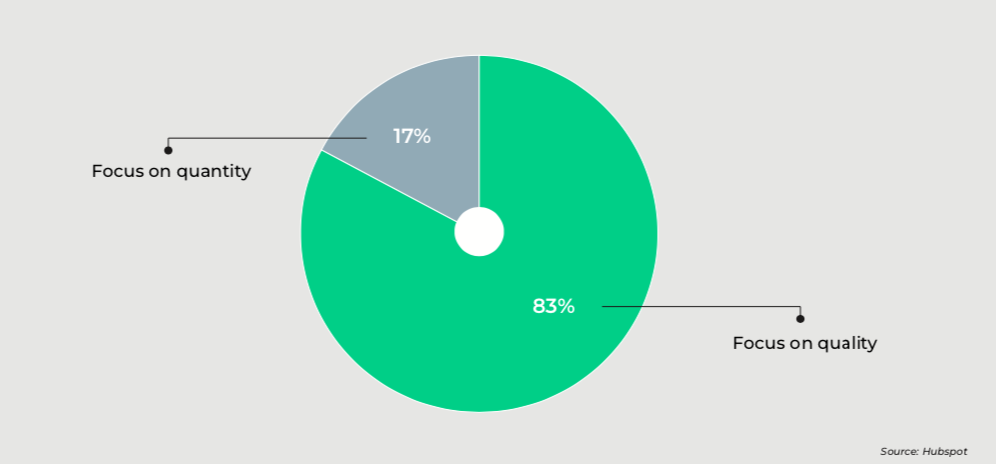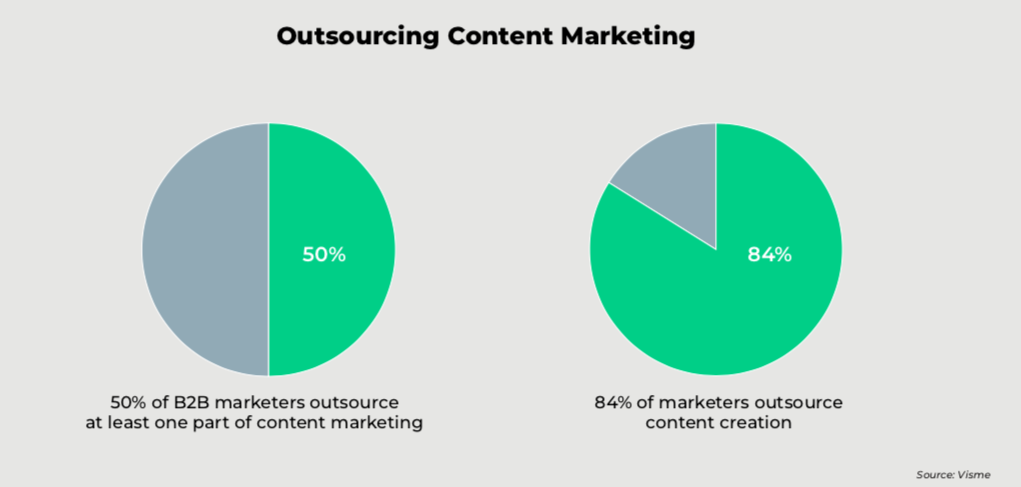Table of Contents
Introduction
In the world of content creation, consistency is key. Because of this 50% of creative and marketing professionals prioritize creating consistent content experiences on all platforms. Whether you’re writing blog posts, social media updates, or website copy, having a well-defined style guide can make a world of difference in the quality and effectiveness of your content. But what exactly is a content style guide?

Put simply, a content style guide is a set of rules and guidelines that ensure consistency in your brand’s content. It serves as a reference for writers, editors, and anyone involved in creating content for your organization.
From language and tone to formatting and grammar, a content style guide outlines the specific style and standards that creators should follow.
Content style guides should not be confused with brand style guides. While there may be some overlap between content style guides and brand style guides, they serve different purposes and focus on different aspects of your organization’s communication and branding. Here are the main differences:
Content Style Guide:
A content style guide primarily focuses on the style, tone, and guidelines related to content creation. It’s specific to the content produced by your organization, such as blog posts, articles, social media updates, or website copy. A content style guide typically covers:
- Language and tone: A content style guide provides guidelines for the language, tone, and messaging used in your content to effectively communicate with your audience. It helps create consistency and ensures that your content aligns with your brand’s values and goals.
- Formatting and grammar: Content style guides include instructions for formatting, grammar, punctuation, and usage to ensure consistency and professionalism in your written content. They outline specific rules about capitalization, abbreviations, citation styles, and other writing conventions specific to your organization.
Brand Style Guide:
A brand style guide focuses on the overall representation and perception of your brand. It encompasses all elements of your brand’s visual identity, including logos, colors, fonts, imagery, and typography. A brand style guide typically covers:
- Visual identity: A brand style guide defines the visual elements that represent your brand, ensuring consistency in the use of logos, colors, fonts, and imagery across various brand touchpoints. It helps maintain a cohesive visual identity and strengthens brand recognition.
- Brand voice and messaging: While a brand style guide may touch on some aspects of language and tone, its primary focus is on the visual elements. It typically outlines general guidelines for brand voice, messaging, and key brand attributes, but in less detail as a content style guide.
In short, a content style guide is more specific to the writing and communication aspects of your brand’s content, ensuring consistency, professionalism, and effective messaging. On the other hand, a brand style guide is broader in scope, focusing on the visual identity elements that represent your brand, helping to maintain a cohesive and recognizable brand image.
Chapter 1: 5 Reasons You Should Create a Content Style Guide
Content style guides can help marketers in numerous ways. Here are the top five reasons every modern business should have one.
1. Effective Customer Communication
By creating a content style guide, you center your audience and ensure that your content is tailored to their needs. The guide can include information about preferred language, tone, and messaging that will resonate with your target audience. This helps establish a strong connection with your customers and improves their overall experience with your brand.
2. Consistent Content Style
A content style guide ensures that your content maintains a consistent and professional appearance. It outlines guidelines for formatting, grammar, punctuation, and usage that need to be followed across all communication channels. Consistency in style enhances the credibility and professionalism of your brand and helps establish brand recognition.
3. Better Content Quality
For 83% of content marketers, producing high quality content is more important than being able to post content often. Adhering to a content style guide can significantly improve the quality of your content. The guide can include best practices for writing, such as using active voice, avoiding jargon, and incorporating storytelling techniques. Following these guidelines ensures that your content is engaging, informative, and well-structured, ultimately enhancing the value it provides to your audience.

4. Clear Writer Expectations
The majority (84%) of marketers outsource content creation. When set rules and guidelines are outlined in a content style guide, there’s less room for confusion among writers. They know what is expected of them and can produce content more efficiently. By providing clear instructions on topics like word count limits, keyword usage, and formatting preferences, you save time and effort in revisions and avoid back-and-forth communication about content expectations.

5. Scalable Workflow
A content style guide is a valuable resource when onboarding and training new team members. It provides them with a comprehensive reference that helps them understand your brand’s voice and style quickly. This not only ensures consistency but also speeds up the onboarding process, allowing new creators and editors to become productive faster. With a scalable workflow, you can easily expand your content creation team and maintain the same level of quality across all materials.
Chapter 2: What to Include in a Content Style Guide
Each business has its own requirements for a content style guide. However, there are some elements that every content guide has in common. Here are the must-have and optional elements you should include in your business’ content style guide.
Must-Have Elements
A. Introduction and Writing Goals
The introduction section of a content style guide provides an overview of the purpose and goals of the guide. It explains why the guide is necessary, who it is intended for, and what benefits can be gained from adhering to its guidelines. This section should also set the tone for the rest of the guide, emphasizing the importance of consistency and clarity in written content.
B. External Style Manual (AP, Chicago) and Dictionary
Choosing an external style manual, such as the Associated Press (AP) or Chicago Manual of Style, is crucial for maintaining consistency across all written materials. These manuals offer detailed and specific rules and guidelines for matters like capitalization, spelling, citing sources, and punctuation. Additionally, including a recommended dictionary ensures consistent spelling, capitalization, and hyphenation and helps to avoid confusion or inconsistencies.
C. Voice and Tone
The voice and tone section of a content style guide outlines the preferred style of writing to be used in all content produced by the organization. Voice refers to the personality and style of the writing, and tone refers to the mood or attitude conveyed. This section should capture the organization’s unique personality, whether it’s friendly, professional, authoritative, or conversational. Providing examples and guidelines on how to achieve this voice and tone will ensure consistency and coherence in communication.
D. Usage, Grammar, and Punctuation
This section focuses on usage and style choices related to grammar and punctuation for the organization’s content. It can cover topics like localization and preferences around sentence structure and the use of commas, semicolons, and quotation marks. Including examples and reminders about common grammar mistakes and how to correct them helps writers produce error-free content.
E. Formatting
Formatting refers to the guidelines for how the content should be presented visually. This section may cover aspects such as font style and size, line spacing, use of headings and subheadings, bullet points, numbering, indentation, and any other specific formatting preferences for different types of content. Consistent formatting ensures a professional and cohesive appearance across all written materials.
F. Word List and Industry Terminology
Including a word list and industry terminology section can help maintain consistency in the use of specific words, terms, or jargon related to the organization’s industry or field. This section may include spelling variations, words to avoid, or preferred alternatives. By creating a shared vocabulary, this section ensures that the organization’s content accurately and consistently represents its subject matter.
Optional Elements
By incorporating these elements in a content style guide, an organization can establish clear and comprehensive guidelines for writers, editors, and other content contributors, enabling them to create content that is consistent, professional, and aligned with the organization’s goals and values. Apart from these must-have elements, there are some additional elements that you can include in your content style guide to make it more comprehensive.
G. Citations
Including guidelines for citations can be beneficial for businesses that frequently reference external sources or utilize data and statistics in their content. This section can detail the preferred citation style, such as APA or MLA, and provide instructions on how to properly cite sources within the text and in the reference list or bibliography. Incorporating this element ensures accurate and reliable information is being used and attributed correctly and consistently
H. Approved and Unapproved Content
Most Americans (82%) want businesses to share their values. This has encouraged more businesses to speak out about issues that they might have previously ignored. In businesses where multiple stakeholders or teams contribute to content creation, it can be helpful to have a section that outlines the types of content that are approved for publication and those that are not. This can include guidelines on specific messaging, controversial topics, restricted language, or prohibited content. By clearly defining what is approved or unacceptable, businesses can maintain brand consistency and avoid inconsistencies, misalignment with their audience, and even potential legal or reputational issues.

I. Examples
Examples of both well- and poorly executed content can be a valuable reference for content creators. These examples can demonstrate the preferred style, tone, formatting, and use of industry terminology, helping writers understand and apply the guidelines effectively. Examples serve as practical illustrations and allow for better alignment with the goals and expectations of the business.
J. Customer Avatar
A customer avatar section provides a detailed description of the target audience or ideal customer. Including this information in a content style guide helps content creators understand who they’re writing for, enabling them to craft content that resonates with the intended audience. This section can include demographic information, interests, pain points, and preferred communication styles. Having a clear understanding of the customer avatar or persona ensures that content is tailored to meet their needs and preferences.
K. Quick Snapshot / TL;DR
A quick snapshot or “Too Long; Didn’t Read” (TL;DR) summary section can provide a brief overview of the most important elements of the content style guide. This condensed version allows users to quickly reference key guidelines without having to read the entire guide. It can serve as a handy reference or reminder of the main rules and principles to follow.
L. Guidelines for Content Type and Channel
This section focuses on providing specific guidance related to different content types and channels. For instance, businesses may have different guidelines for blog posts, social media content, emails, or whitepapers. Each content type may have its own style requirements, length considerations, and formatting guidelines. Similarly, different channels, such as Facebook or LinkedIn, may have their own specific tone, language, and formatting expectations. Providing specific instructions for various content types and channels ensures consistency and appropriate presentation across different platforms.
Chapter 3: 9 Steps to Creating an Effective Content Style Guide
Once you know that you want to create your own content style guide, you can follow these steps to create a resource that can help your team deliver consistently engaging and aligned content.
Step 1: Review Your Brand’s Mission and Values
Start by understanding your company’s mission and values, as they form the foundation of your content style guide. Consider what message you want to convey to your audience and how your content can align with your brand’s overall goals.
Step 2: Create a Customer Avatar
Develop a clear understanding of your target audience by creating a customer avatar or series of personas. This includes identifying your ideal customer’s demographics, needs, challenges, and preferences. Understanding your audience this way will help you tailor your content to their specific interests and language.
Step 3: Involve Teammates
Collaboration is essential when creating a content style guide. Involve your team members from different departments who contribute to the content creation process. This promotes consistency across all content and ensures that everyone has a say in the guidelines.
Step 4: Choose a Format (Doc, Presentation, Wiki)
Decide on the format for your content style guide. It could be a document, a presentation, or an online wiki. Choose a format that is easily accessible and can be updated regularly as your brand evolves.
Step 5: Define Your Company’s Voice
Determine your brand’s voice, which is the consistent personality or character behind your content. It should align with your brand’s identity and values. Consider whether your brand’s voice is authoritative, friendly, humorous, or formal, and then formulate guidelines for maintaining this voice throughout your content.
Step 6: Define Your Company’s Tone
While the voice remains consistent, the tone can change depending on the specific message or context. Decide on the different tones you might use in your content, such as informative, motivational, empathetic, or persuasive. Provide guidance on when and how to use these different tones effectively.
Step 7: Establish Guidelines for Style
Set guidelines for the style of your content, including rules for formatting, grammar, and punctuation. This ensures consistency and professionalism in all your written content. For example, specify which style guide (such as AP or Chicago) to follow and provide examples for common writing issues.
Step 8: Choose What Other Elements Your Guide Will Include
Consider additional elements to include in your content style guide. This may include instructions for incorporating brand-specific keywords, guidelines for visual elements like images and videos, instructions for creating headlines and subheadings, and rules for citing sources or linking to external content.
Step 9: Keep Updating
A content style guide is not fixed in stone, and should be a living document. As your brand grows and changes, your guidelines will need to be updated accordingly. Allocate resources to review and update the content style guide regularly to ensure it remains relevant and aligns with your evolving brand identity.
Remember, a content style guide is meant to provide consistency and clarity to everyone involved in content creation. It serves as a central resource that helps maintain your brand’s voice, tone, and message throughout all your content channels.
Get the latest growth ideas, strategies, and best practices delivered to your inbox.
Quick read that helps 7000+ subscribers.
Chapter 4: 3 Examples of Content Style Guides
Content style guides provide a framework for creating consistent and effective content. They are essential tools for organizations looking to maintain a strong brand identity and deliver high quality communications. In this section, we will explore some examples of successful content style guides that have helped companies and institutions create clear, engaging, and effective content. These style guides serve as great models for anyone looking to establish their own content standards and achieve greater success with their communications.
Example 1: Mailchimp
Mailchimp is a leading marketing platform that provides businesses with the tools they need to create, manage, and analyze email marketing campaigns. Its style guide has specific guidelines and rules for each type of content and topic. This allows stakeholders to adjust their tone and voice according to their content but still remain consistent with Mailchimp’s overall brand voice.

Example 2: Microsoft
Microsoft is a multinational technology corporation known for its wide range of software, hardware, and services. Its content style guide documents and formalizes the brand ideology and content guidelines that every marketer, business department, and vendor is expected to adhere to.

Example 3: Government of Canada
Businesses are not the only organizations that can benefit from a content style guide. Style guides can be useful for any group that engages in internal or external communication. The Government of Canada has a successful content style guide to ensure that tone and word choice remain consistent across all government communication channels.

Deliver Better Brand-Aligned Content With LeadsPanda
LeadsPanda can help businesses create a content style guide as part of a complete content strategy tailored to the business’s specific requirements and goals. By including important guidelines in the content style guide, businesses can develop a consistent brand identity and maintain a cohesive content strategy.
LeadsPanda also has a team of professional writers and journalists who create persuasive and entertaining content to align with your business’s desired style and tone. LeadsPanda can help you with your content needs. Contact us for a free consultation.



